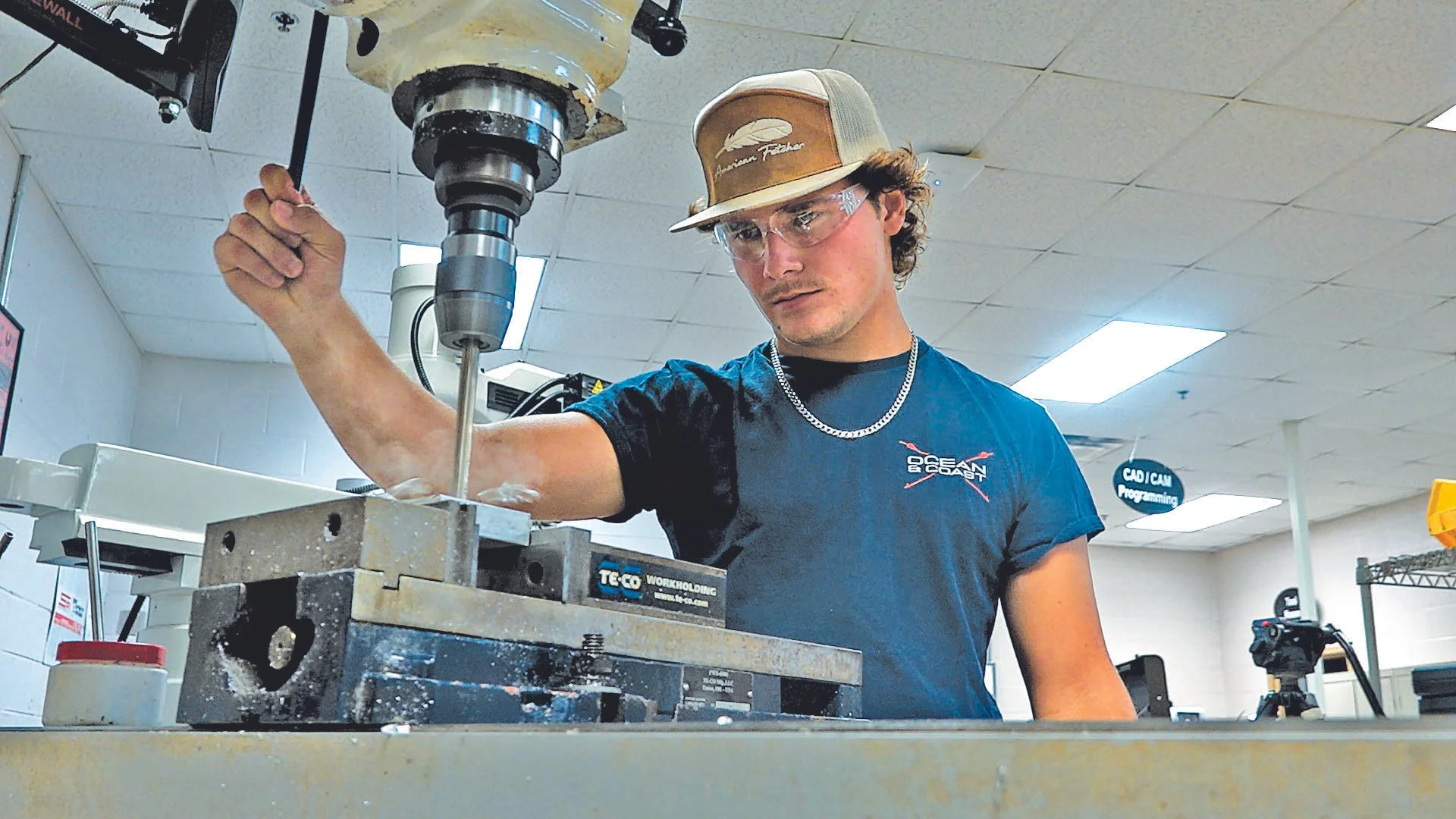Coweta’s Central Educational Center
The Birthplace of Innovative Career Education in Georgia
Written by REBECCA LEFTWICH | Photographed by CEC interns: JONAH BUTLER, LUIS VARGAS and JAY CANSLER
Blake Smelcer works in the machine tool lab at CEC, where the first German-style apprenticeship program in the U.S. was piloted.
Fifty-three college and career academies in Georgia alone are modeled on it. The state has spent $160 million to replicate it. National educational programs have originated from it.
It’s the Central Educational Center (CEC), and it started in Coweta County almost 25 years ago with a vision, a unique partnership and a school building that was sitting empty, ready for the dawn of a new millennium.
Typical Coweta County high school graduates in the 1990s were unprepared for a workplace increasingly shaped by global business, downsizing and automation, and local business representatives approached the Coweta County School System with their concerns.
It was the start of a beautiful friendship.
Aimed at “seamless education,” the CEC was developed by Newnan-Coweta Chamber of Commerce leaders, the Coweta County School System and West Georgia Technical College. It was developed from two years’ worth of work by a steering committee headed by the late Dr. Joe Harless, a behavioral psychologist whose ideas for educational change included educating students in an environment that simulated the real-life workplace as closely as possible.
Because no educational model existed for the program, then-Superintendent Richard Brooks engaged Harless to apply his principles with specific input from local business industry and local schools.
Mark Whitlock, who has served as the CEO of the Central Educational Center since its inception, became involved with the school system in the mid-1990s, investigating chartering laws and helping grow a local Montessori school.
“It was disappointing that education was not more focused on careers,” Whitlock says. “There were a lot of good companies here, and it was a time period where everything pointed toward Coweta, and Coweta was booming. They said, ‘Let’s develop something unique in Coweta.’”
College and Career Academies
All of Georgia’s college and career academies are modeled on CEC, allowing high schools throughout the state to offer an ever-widening range of accelerated, dual-enrollment opportunities in technical education. Its beefed-up, work-based learning strategy and alignment with West Georgia Technical College paved the way for local implementation of the first German-style apprenticeship program in the country.
These and other accomplishments have brought it wide acclaim as a high school reform model.
More than 500 groups from Georgia and across the U.S. – as well as groups from 16 other nations – have visited CEC to study its model, and Whitlock regularly travels to other communities to help them with replication efforts. The 2013 Georgia College and Career Academy of the Year, CEC in 2018 was designated by the International Center for Leadership in Education as one of the nation’s 30 replicable high school reform model programs.
Dr. Anthony Chow conducted research on CEC for his book, “Systems Thinking and 21st Century Education: A Case Study of an American Model for High School Educational Reform.”
The CEC serves as a shining example of the partnership between businesses, school systems and technical colleges in an intentional effort to systematically impact economic development by ensuring competitive talent for current and future careers, according to Whitlock. And that talent is emerging and being identified in younger and younger students as learning opportunities continue to blossom and programs are added and expanded, he adds.
First chartered in 1999, CEC recently was granted another five-year charter amidst enthusiastic recommendations from the Georgia Department of Education, the Technical College System of Georgia and the Coweta County Board of Education. It didn’t hurt that CEC also completed the requirements for Dr. Joe Harless College and Career Academy certification – something CEC’s creation, purpose and evolution has helped define.
Years before laws officially established them, says Whitlock, “college and career academies originated here.”
Interested in the success of the program, state department of education officials asked the CEC leadership team to look at developing replications, resulting in the establishment of four future Georgia college and career academies between 2003-2005.
In 2006, a 210-page manual called “Strengthening Education to Drive Economic Development: A Manual for Replicating The CEC Experience in Your Community” was published and distributed, shortly before Georgia law officially brought college and career academies into existence.
Business and
industry-led education
In 2007, then-Lt. Governor Casey Cagle established Georgia’s College and Career Academy Network. The state sets aside funds in its budget each year to help school systems build college and career academies. The accountability structure may seem familiar.
“The law set up college and career academies to report to an Office of College and Career Academies, housed within the Technical College System (of Georgia)” says Whitlock. “Because college and career academies were so focused on technical education, it was done this way. And, of course, that all came out of the way this community structured CEC.”
From the beginning, business and industry has guided CEC’s work, engaging with education and the community to encourage career success in students nearly a decade sooner than the average worker. Students now have the opportunity to graduate from high school having earned technical certification, workforce experience and college credit.
Focusing on workforce development at a younger and younger age doesn’t just benefit companies. It’s important for entire communities, Whitlock says, and for hard-to-reach students who can become interested enough in a course of study to not only graduate but pursue further education.
“We just can’t afford to lose kids, because we’ve got to have skilled young people to drive our economy,” he adds.
It’s why CEC keeps its finger on the pulse of the shifting business and industry standards, constantly taking stock of new and changing trends and expanding opportunities for the students who are – or soon will be – looking to join the workforce.
Accelerated career programs
Many can now do so through accelerated career programs, which are a way to earn a high school diploma by doing “a little bit of high school and a whole lot of technical college” – something that followed in the wake of CEC piloting in 2016 the first German-style apprenticeship program in the U.S.
The CEC currently has 132 of the approximately 550 students statewide in the apprenticeship program, which has doubled from just three years ago and split into two specialized parts: industrial mechanics and machine tools.
Dental assisting and nurse aide are other programs that have been added to the accelerated career program.
“That’s because the state said, ‘Let’s look at more of the high-demand careers, and let’s make sure we approve those to be part of the accelerated career program,’” Whitlock says. “It’s a function of people understanding how to listen to business and industry and to respond with policy. And that’s great for students and great for employers.”
Innovation starts with intention, according to Whitlock, who says, “When you start with intentionality, like this community did in creating something like CEC, it’s like Joe Harless used to tell us: ‘You’ll be amazed over time at the kinds of synergies that develop.’”
As always, CEC is looking toward the future. Senate Bill 86, passed last year, will allow students to access HOPE and career grant funds as early as 10th grade, saving dual-enrollment money for core academic college classes in 11th and 12th grades and allowing students to get even closer to completing associate degrees by the time they graduate from high school.
Currently, CEC serves about 1,100 students in grades 8-12 daily and another approximately 200 who are either adult students or students from outside the Coweta County School System. That can include home-schooled students and students from private schools, because the law permits those students to take classes at a college and career academy provided there is space available.
Today’s college and career academies have redefined “vo-tech” education, and students’ post-graduate success has removed much of the stigma.
“Kids who graduate from accelerated career programs are making an average of $40,000 when they leave high school,” Whitlock says, adding that CEC is all about options for students as they look toward their own futures.
‘Continuous improvement’
Programming is based on the direction of the economy, so students have more options that they can take advantage of, and those options follow the direction of the economy. That’s how CEC started, and that’s how it continues to change and grow.
“We’re now at a point where about one out of every two high school graduates in Coweta County is a part of CEC at some time before they graduate,” Whitlock says. “That begins to fit what the economy is saying – that up to 70 percent of jobs are going to require something beyond traditional high school. And that might be a bachelor’s degree, an associate degree, an apprenticeship or a certificate, or an internship.”
While much of CEC’s ahead-of-the-curve work is widely regarded as “educational reform,” supporters of industry-driven instruction prefer a more open-ended, business-oriented concept: continuous improvement.
“Continuous improvement is a lot of new and different things, and that’s why it’s exciting,” Whitlock says. “You’re always working in a direction, never finished, so there’s always something to do. You’re always reanalyzing needs, redesigning what you need to do in the next iteration. It’s the intersection of education and business, and CEC is designed to be that.” NCM

